Godzilla Minus One (2023, Dir. Takashi Yamazaki):
Godzilla—monster, nightmare, savior, man in suit, CGI freak—has undergone so many iterations and revisions over the years that it’s worth revisiting the very first Godzilla film from 1954 (and we’re not talking about the Americanized cut with Raymond Burr telling the audience he can hardly believe what has just happened). An apocalyptic creature birthed from Japanese fears of post-nuclear holocaust, the original Godzilla didn’t have a purpose, heart or conscience; it was an irradiated gargantuan created from destruction and compelled to destroy, and if the filmmaking behind the 1954 Godzilla was primitive in some respects, it suited the primitive nature of the story to a tee. What endures the most from the film aren’t the pyrotechnics and the man-in-suit acting, impressive as they are for the time, but its almost funereal pacing, the juxtaposition of true-life horror (lingering shots of scarred and burned radiation victims) with the sight of Godzilla rising from the deep at night like a colossus emerging from the depths of a fever dream, the inexorable march of Akira Ifukube’s iconic soundtrack matching the giant beast stride for stride.
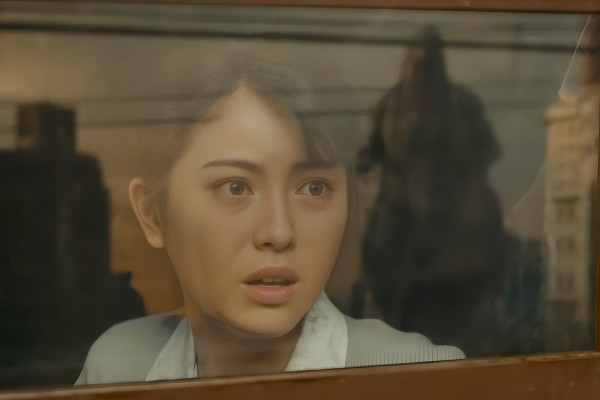
Since then, most of the Godzilla sequels, including several ill-considered American reboots, have been more about the spectacle—More kaiju! Multiple men in suits! More methods of annihilation!—and haven’t amounted to much beyond camp value (not that there’s anything wrong with that, as Seinfeld would say). Human drama was never central to the Godzilla mythos, but Godzilla movies are at their best when they’re charged with recognizable human anxieties: the threat of mass destruction, the notion that a city could be built up again from the ashes of war, only to be re-levelled by hubris and the whims of an angry titan.
Those fears have been resuscitated by Godzilla Minus One, which takes us back to the beginning and beyond, setting the action at the tail end of World War II. The latest entry in the franchise even has an honest-to-goodness human protagonist: Shikishima (Ryunosuke Kamiki), a disgraced kamikaze pilot haunted by an initial encounter with Godzilla in which he was paralyzed with terror, resulting in the deaths of dozens of comrades. With his delicate, guilt-ridden countenance, Shikishima is one mopey dude, but in the annals of Godzilla cinema, this qualifies as full-blooded characterization. In the first act, director Takashi Yamazaki takes his cue from early Akira Kurosawa films, keeping matters down-to-earth and humane as Shikishima struggles to eke out a living in the ruins of post-war Tokyo. Much time is devoted to ne’er-do-wells: Shikishima builds a new surrogate family with a young thief (Minami Hamabe) and an orphaned baby girl (Sae Nagatani) while befriending an eccentric naval engineer (Hidetaka Yoshioka), a boisterous boat captain (Kuranosuke Sasaki) and his gung-ho first mate (Yuki Yamada). Instead of cardboard heroes, we get disillusioned veterans, bereaved and bereft housewives, shaken survivors only beginning to get back on their feet.
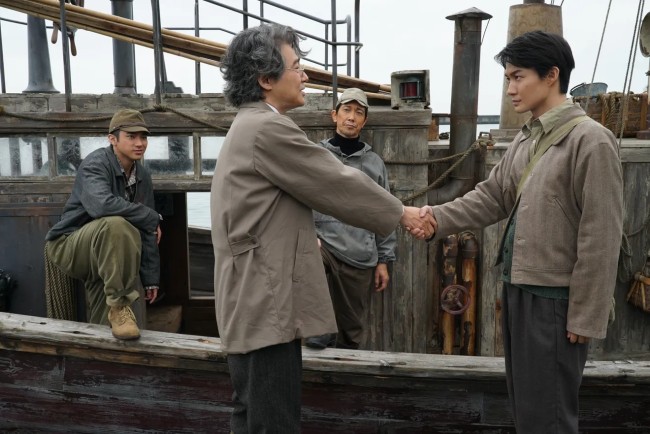
For those who might find these initial scenes a bit labored—and let’s face it, as agreeable as Yamazaki is as a director, he’s not Kurosawa when it comes to drama—fear not: the Big One shows up soon enough, and when it does, it’s in a whopper of an action scene in which Shikishima and his boating buddies come under direct attack. As is par for the course for a Japanese film, the special effects are a bit ropey, but who needs versimilitude when depicting an ancient dinosaur-like creature with radioactive breath? This is a Godzilla that stays true to its initial conception and feel, retaining the beady eyes, frozen snarl and hypnotic herky-jerk moves of the original even as a few glossy touches are added, including glowy dorsal spikes that pop into place just before Godzilla unleashes its radioactive rays. Like the film, the creature is a bit baggy, a bit misshapen, but when it hits, you feel it.
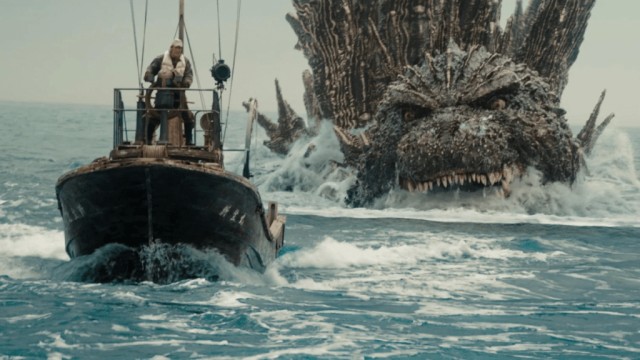
In contrast to Hollywood versions of Godzilla in which overlong passages are devoted to wanton destruction, the action scenes in Godzilla Minus One are quick and concise. Maybe too quick and concise; the film understands that Godzilla, like the shark in Jaws, is at its best when deployed sparingly, but its appearances don’t carry the same sense of build-up and impending doom that mark his best incarnations. Instead we get abrupt cuts to Godzilla suddenly appearing on land, glimpses of the beast’s feet as it tramples hundreds of fleeing Tokyoites, abbreviated shots of annihilation. Godzilla has always been a rated-PG proposition, but much of the damage wrought in this movie comes off as bloodless and cursory, as the camera moves on every time bodies are about to be squished or incinerated.
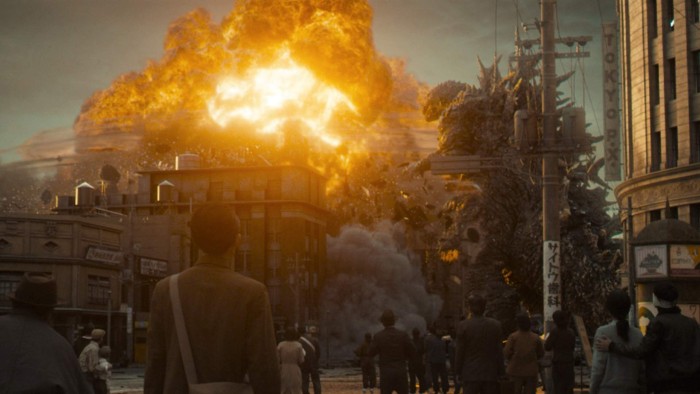
This next battle is not one waged to the death, but a battle to live for the future.
Noda (Hidetaka Yoshioka)
A cursory Godzilla? Sounds like a fatal flaw, but Godzilla Minus One succeeds because the character work pays off. For once, we root for the underdog humans as they scramble to defeat the monster, and in the process, Yamazaki celebrates old-fashioned “we’re all in this together” teamwork even as he updates the themes of patriotism and sacrifice that have informed many a Japanese wartime picture. This time it isn’t a funky government agency or alien tech that will save humankind, but plucky citizens and spiritually wounded war veterans, including Shikishima and his embittered mechanic Tachibana (Munetaka Aoki, turning in the most affecting performance). Instead of shouts of “banzai” and heroes willingly going to their deaths, the clarion call is to live, and endure.
Most of all, the film is thematically of a piece: Godzilla and post-war Japan are karmically connected, both battered by radiation, both attacked and enraged, both engaged in a duel for survival. When Shikishima witnesses the re-devastation of Tokyo, black rain falling on his face, the image recalls Japan’s real-life rain of nuclear hellfire even as it reimagines it in a sci-fi context. And when he takes to the skies once more to face his destiny (and literal demon) in a prototype Shinden plane—an instrument of destruction repurposed for a mission of preservation—and Ifukube’s familiar theme breaks in on the soundtrack, it’s near-impossible not to get swept up in the emotion of the moment, and marvel at the realization that one can enjoy a Godzilla movie that centers on one man’s redemption.
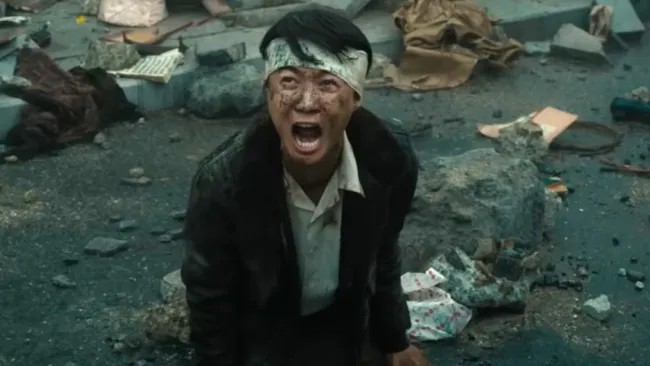
Occasional clunky dramatics and all, Godzilla Minus One makes for a rousing movie, and serves as a welcome reminder that it’s still possible to create mainstream entertainment that mixes smarts and shameless crowd-pleasing storytelling. Speaking of crowd-pleasing, if the conclusion of the movie feels a bit too sunny, a bit overcrowded with good vibes, at least the feels are well-earned, and as expected, a final shot suggests that sequels are in the works. Will the human element be exploited as successfully in future Godzillas as it is here, or will we return to the usual four-course monster meal of full-scale slaughter? The answer should be fascinating, as fascinating as Godzilla itself has proven to be throughout its seven decades of existence. ■

